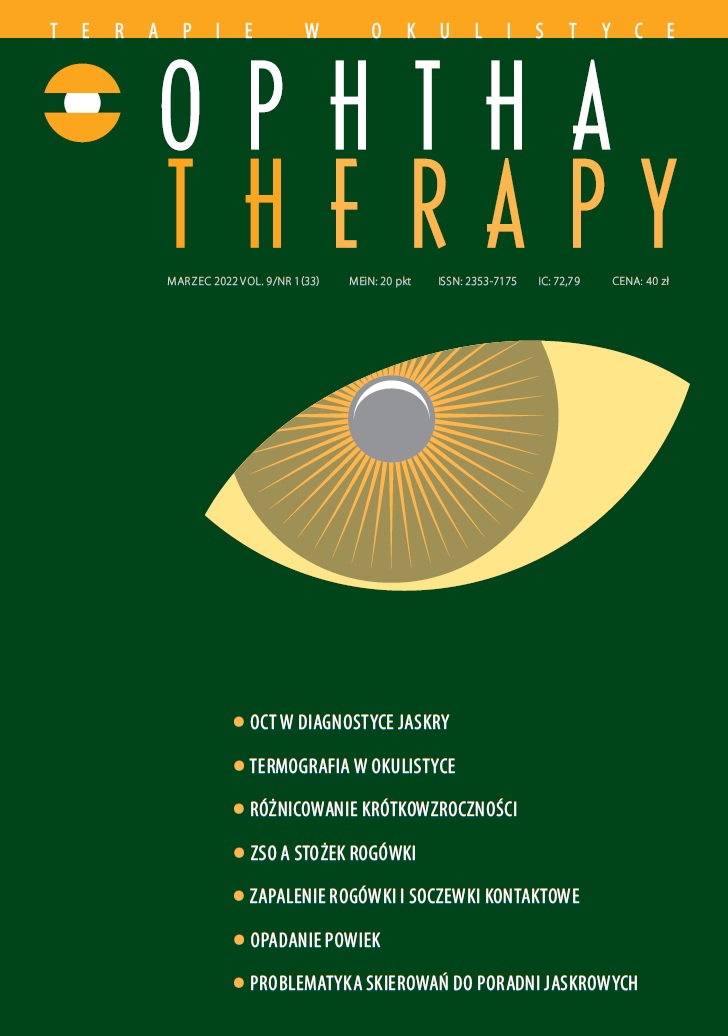Myopia differential diagnosis Review article
Main Article Content
Abstract
Due to the prevalence and the possibility of myopia progression, myopia is currently of particular interest to many specialists in both the field of optometry and ophthalmology. In the initial diagnosis of the patient, it is important to determine whether the refractive error is isolated or if it coexists with other eye disorders/diseases or general health problems. This refractive error can be divided into axial and refractive myopia. In the latter case, the change in refraction may result from too great curvature of the cornea in relation to the length of the eyeball, or an increase in the optical curvatures other than the anterior surface of the cornea, or an increase in the refractive index of at least one of the optical structures, or a shallower anterior chamber of the eye. It is also worth distinguishing myopia associated with complex syndromes.
Uncorrected myopia can significantly hinder daily functioning. It is therefore important to detect it as early as possible, correct it properly.
Downloads
Article Details

This work is licensed under a Creative Commons Attribution-NonCommercial-NoDerivatives 4.0 International License.
Copyright: © Medical Education sp. z o.o. License allowing third parties to copy and redistribute the material in any medium or format and to remix, transform, and build upon the material, provided the original work is properly cited and states its license.
Address reprint requests to: Medical Education, Marcin Kuźma (marcin.kuzma@mededu.pl)
References
2. Benjamin WJ, Borish IM. Borish’s clinical refraction. Butterworth & Heinemann, 2006.
3. Angle J, Wissmann DA. A statistical analysis of the Biological Theory of spherical error of refraction. Am J Optom Physiol Opt. 1979; 56(5): 309-14.
4. Wu PC, Huang HM, Yu HJ et al. Epidemiology of Myopia. Asia Pac J Ophthalmol (Phila). 2016; 5(6): 386-93.
5. Brennan NA, Toubouti YM, Cheng X et al. Efficacy in myopia control. Prog Retin Eye Res. 2021; 83: 100923.
6. Grzybowski A, Kanclerz P, Tsubota K et al. A review on the epidemiology of myopia in school children worldwide. BMC Ophthalmol. 2020; 20(1): 27.
7. Lam CSY, Tang WC, Tse DY et al. Defocus Incorporated Multiple Segments (DIMS) spectacle lenses slow myopia progression: a 2-year randomised clinical trial. Br J Ophthalmol. 2020; 104(3): 363-8.
8. Grosvenor T. A review and a suggested classification system for myopia on the basis of age-related prevalence and age of onset. Am J Optom Physiol Opt. 1987; 64(7): 545-54.
9. Skuta GL, Cantor LB, Weiss JS. Optyka kliniczna (BCSC cz. 3). Elsevier Urban & Partner, Wrocław 2008.
10. Bowling B, Kanski JJ. Okulistyka kliniczna. Wydanie V. Edra Urban & Partner, Wrocław 2017.
11. Zimmermann-Górska I. Zespół Ehlersa i Danlosa. https://www.mp.pl/pacjent/reumatologia/choroby/142137,zespol-ehlersa-i-danlosa.
12. Kański JJ, Nischal KK. Okulistyka. Objawy i różnicowanie. Urban & Partner, Wrocław 2000.
13. Kokot F. Choroby wewnętrzne. PZWL, Warszawa 2000.
14. Banks MS. Infant refraction and accommodation. Int Ophthalmol Clin. 1980; 20: 205-32.
15. Roy FH. Ocular Differential Diagnosis. Lippincott Williams and Wilkins, 1997.
16. Ostrowska M. Miastenia. https://www.mp.pl/pacjent/neurologia/choroby/150964,miastenia.
17. Gwinup G, Villarreal A. Relationship of serum glucose concentration to changes in refraction. Diabetes. 1976; 25(1): 29-31.
18. Kastelan S, Gverović-Antunica A, Pelcić G et al. Refractive changes Associated with diabetes mellitus. Semin Ophthalmol. 2018; 33(7-8): 838-45.
19. Guggenheim JA, Williams C. Childhood febrile illness and the risk of myopia in UK Biobank participants. Eye. 2016; 30(4): 608-14.
20. Wozniak JR, Riley EP, Charness ME. Clinical presentation, diagnosis, and management of fetal alcohol spectrum disorder. Lancet Neurol. 2019; 18(8): 760-70.

